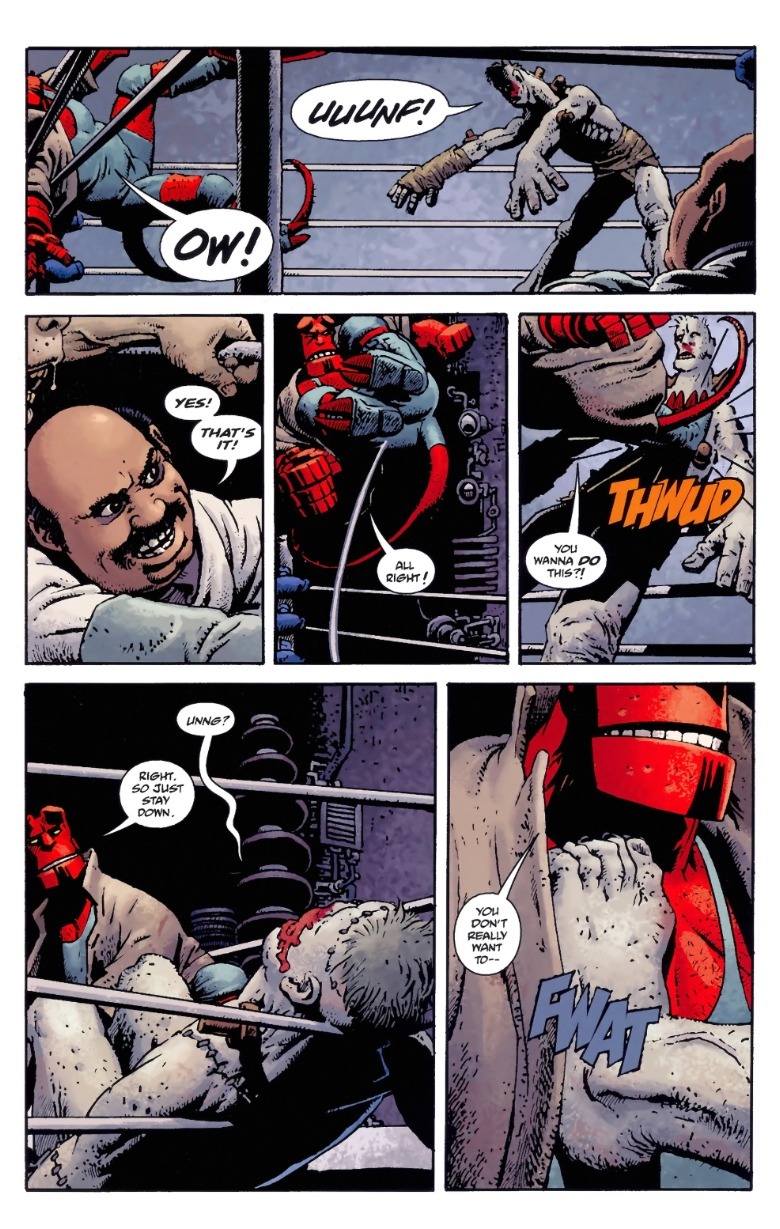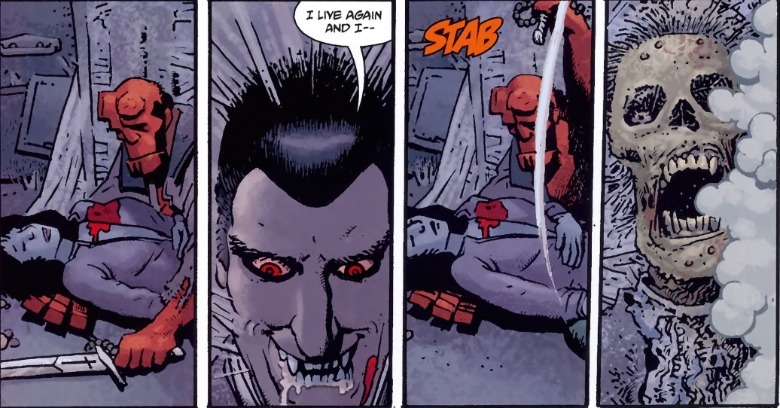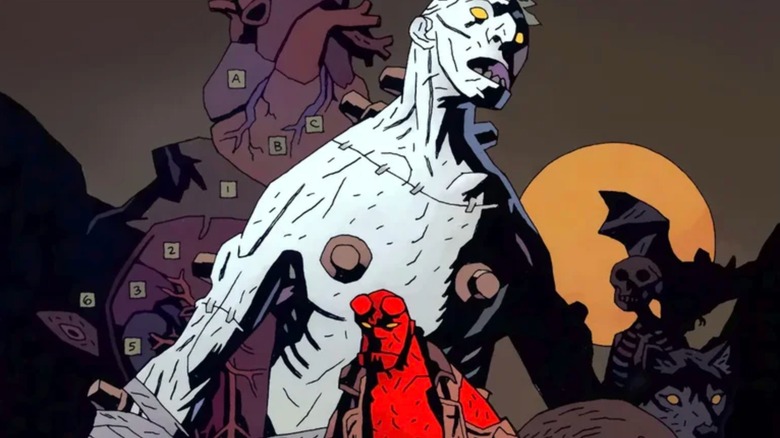Frankenstein's Monster Once Fought One Of Comics' Best Superheroes
We may receive a commission on purchases made from links.
Guillermo del Toro's "Frankenstein" arrived more than 20 years after one of his other beloved movies about a monster learning to be a man — "Hellboy." Like the Creature, Hellboy was summoned into this world through no will of his own by men treading into God's domain. Since he was raised with love, he grew up into a monster-hunting hero, joined by his colorful coworkers at the Bureau for Paranormal Research and Defense (BPRD).
What if I told you that these two characters had actually met once in the pages of Mike Mignola's original "Hellboy" comics? Hellboy winds up in a wrestling ring with the brainwashed Monster during the "Hellboy in Mexico" arc. Set in 1956, Hellboy goes AWOL for several months and has some booze-fueled misadventures across Mexico; hence, the other title for the original one-shot, "A Drunken Blur." He even briefly becomes a luchador, or a masked Mexican wrestler. (That's a long story, but "Hellboy in Mexico" is one worth reading.)
Hellboy faces Frankenstein in "Hellboy: House of the Living Dead," drawn by Richard Corben, who also drew the movie-inspiring arc "Hellboy: The Crooked Man." In Mexico, Hellboy is lured to a private wrestling match held by the villainous Dr. Kogan, when Hellboy goes to rescue a woman, Sonia, who Kogan is holding hostage. First, he has to wrestle Kogan's champion, Frankenstein, introduced by being awoken with an electrical generator.
(In the unfinished prequel "Frankenstein Undone" by Mignola and artist Ben Stenbeck, the Monster decides "Frankenstein" is his name since it was his father's. So though it remains a debate whether calling the Creature "Frankenstein" is correct or not, that's what we will do here.)
House of the Living Dead put Hellboy in the ring with Frankenstein
Hellboy initially has the edge, but Frankenstein absorbs his punches and knocks him down. Before he finishes Hellboy off, he comes to his senses and rebels, trashing Kogan's lab. At the comic's end, Hellboy and Frankenstein share a drink in a haunted honky-tonk.
There are a lot of "Frankenstein" comics out there, and the Creature is part of both the Marvel and DC Universes. (The DC version appeared in the animated "Creature Commandos" series, voiced by David Harbour.) What makes the Mignola/"Hellboy" version stand out? Well, Mignola is a bigger fan of the James Whale and Boris Karloff "Frankenstein" movies than he is of Shelley's novel.
Speaking to Vulture in 2015, he said the novel is "kind of dull, but it's got great speeches and a lot of real power to it." Note how Mignola's Frankenstein, even when drawn by Corben and Stenbeck, has the metal rods, stitch scars, and short hair of the Karloff iteration.
"House of the Living Dead" is, per Mignola's foreword, his homage to the crossover films of Universal Horror: "House of Frankenstein" and "House of Dracula." Doctor Kogan has an Igor-like assistant, a detail to the "Frankenstein" myth cemented by the Universal films. Once the wrestling match is over, the book reveals itself as a monster mash.
Kogan's other henchman, Raoul, is a werewolf and chases after Sonia. The book then turns into Hellboy versus the Wolfman, but while Hellboy wins, the Wolfman shoots Sonia (hiding in a crypt) dead. Her blood splatter wakes up a slumbering vampire who looks a lot like Christopher Lee's Dracula. A saddened Hellboy, in no mood for more fisticuffs, stakes him casually:
How Frankenstein fits in the Hellboy universe
Kogan presents himself as the Creature's creator, but Frankenstein later confirms to Hellboy that this is not true. Mignola and Stenbeck picked up from "House of the Living Dead" in 2015 with "Frankenstein Underground," which includes flashbacks of the "Frankenstein" novel; in the "Hellboy" universe, the novel was inspired by true events. This is Victor Frankenstein's Monster, who faced more than a century of isolation among humans. In "Frankenstein Underground," he finally finds peace in the untamed Hollow Earth.
"House of the Living Dead" ends on a melancholic note for Hellboy. He's feeling glum from failing to save Sonia, and an apparition suggests his quest to avoid his Hellish nature is futile.
"You chose to live a man's life — live and suffer like a man — you can do that, but you can never be a man."
These words fit Frankenstein, too, showing why Guillermo del Toro made Hellboy and Frankenstein's Creature so similar. Yet they also contrast each other, offering different conclusions on how nurture overcomes nature. The Creature didn't have to be evil, but chose to spite the creator and world who rejected him. In the novel's conclusion, he delivers a self-pitying monologue where he admits he paid evil unto his creator, but his own woe was still worse than Victor's.
"Frankenstein" is a story about how we make our own destinies for good and ill, while "Hellboy" is a story about becoming your own person despite your destiny. Hellboy looks like the Devil, but his evil runs only skin deep; he's a kind and heroic person, not a vengeful murderer like Frankenstein. Hellboy is prophesied to bring about the apocalypse, but he rejects that fate at every turn. Frankenstein forsook the world, but Hellboy would much rather save it.




